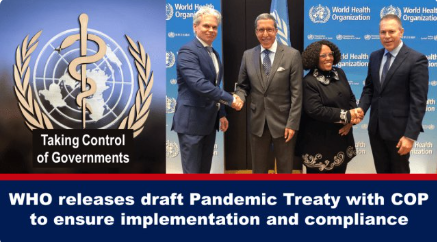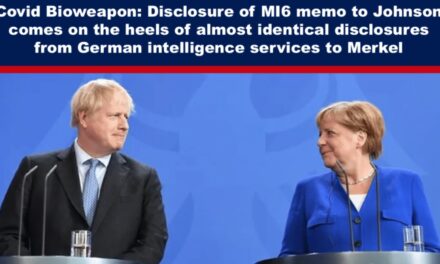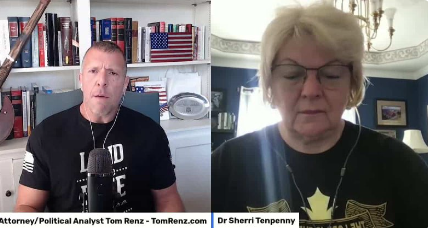A week ago, a draft text of the Pandemic Treaty was released. The text titled ‘Bureau’s text of the WHO CA+’ was drafted by the Bureau of WHO’s Intergovernmental Negotiating Body (“INB”).
Which governments have been negotiating the draft? The World Health Organisation would lead us to believe 194 countries have been involved. But this is misinformation. It would appear none of our governments have been involved.
So, who is WHO’s Bureau?
Note: The proposed Pandemic Treaty has been referred to by a variety of names, even by WHO, some of which are mentioned in this article. But it is formally known as the “WHO CA+,” an abbreviation for “WHO Convention Agreement +.”
The word “pandemic” is not included in the name of the treaty. And together with “+” at the end, could indicate it is a treaty that covers more than pandemics or health. And it does. By way of embedding the One Health approach into its text, the treaty becomes an all-encompassing global dictatorship over all life and the systems that support it.
Drafting and Approving the Pandemic Treaty Text
In December 2021, it was decided at a special session of the World Health Assembly to establish an Intergovernmental Negotiating Body (“INB”), representing all regions of the world, to draft and negotiate “a WHO convention, agreement, or other international instrument on pandemic prevention, preparedness and response” – now referred to as the WHO CA+.
The World Health Assembly convened a second special session in December 2021, where it established an Intergovernmental Negotiating Body (INB) … to draft and negotiate a WHO convention, agreement or other international instrument on pandemic prevention, preparedness and response, with a view to its adoption under Article 19, or under other provisions of the WHO Constitution as may be deemed appropriate by the INB. [Emphasis our own]
DRAFT Bureau’s text of the WHO CA+, Drafting Group of the Intergovernmental Negotiating Body to draft and negotiate a WHO convention, agreement or other international instrument on pandemic prevention, preparedness and response, 22 May 2023
In July 2022, at the second meeting of the INB, it was agreed that the WHO CA+ should be legally binding and contain both legally binding and non-legally binding elements. The INB Bureau was requested to develop and present to the INB a conceptual zero draft of the WHO CA+ for discussion.
As well as Article 19, INB identified Article 21 of the WHO Constitution under which WHO CA+ should be adopted.

In December 2022, at the third meeting of the INB, it was agreed that the INB Bureau, with support from the WHO Secretariat, would prepare the Conceptual Zero Draft (“CZD”) of the WHO CA+. It was also agreed that the zero draft of the WHO CA+ be prepared.
The CZD presented a proposed structure of the elements for the future instrument. “The CZD was intended to be a flexible, ‘living’ document, and was presented as a ‘bridge’ between the working draft presented at the second meeting of the INB and the future ‘zero’ draft of the WHO CA+. In this regard, the CZD was not an official/formal draft of the WHO CA+, was not itself the ‘zero’ draft of the WHO CA+, and was not presented for ‘negotiation’, ‘agreement’ or otherwise to be ‘approved’ by WHO’s Member States,” WHO’s website states.
In March 2023, at the fourth meeting of the INB, the Zero Draft (“ZD”) of the WHO CA+ was considered. The Zero Draft was prepared by the INB Bureau with the support of the WHO Secretariat, based on the CZD and input received during the third meeting of the INB.
In April 2023, at the fifth meeting of the INB, the INB requested the INB Bureau provide a Bureau text to members of the INB Drafting Group no later than 22 May 2023.
The INB Bureau has now prepared the Draft Bureau’s text of the WHO CA+ for consideration by the INB Drafting Group in June 2023.
The INB presented a progress report to the 76th World Health Assembly held in May 2023. INB will present a final outcome to the 77th World Health Assembly to be held in May 2024. In the period leading up to the 77th World Health Assembly, the INB will hold four additional sessions in the first quarter of 2024, as well as two additional sessions of the drafting group in 2023.
From the above, it seems the INB using various names – INB, INB Bureau and INB Drafting Group – are drafting, approving and moving the text of the Pandemic Treaty forward. The only involvement outside the INB has been the WHO Secretariat and a progress report that was given by the INB to the 76th World Health Assembly.
The Secretariat of WHO is staffed by some 8000 “experts” and support staff. It is headed by the Dictator General Tedros the Terrorist. INB preparing a draft with the “support of the WHO Secretariat” could mean WHO staff assisted with the typing.
However, going forward, the Bureau’s text of the WHO CA+ mentions the establishment of a Secretariat for the WHO CA+. The draft document states: “Secretariat functions for the WHO CA+ shall be provided by the World Health Organisation in cooperation with the Food and Agriculture Organisation of the United Nations, the World Organisation for Animal Health and the United Nations Environment Programme.”
It is no coincidence that the Pandemic Treaty will have the same agencies directing operations that are leading the One Health agenda – WHO, the United Nations’ Food and Agriculture Organisation (“FAO”), United Nations Environment Programme (“UNEP”) and the United Nations’ World Organisation for Animal Health (“OIE”) – because the One Health ideology is embedded in the Pandemic Treaty.
So, who makes up the INB?
Members of the Intergovernmental Negotiating Body
We were unable to find a list of the members of INB on WHO’s website. But we did find minutes of its meetings which show the “participants.” And we were able to confirm who chairs the Bureau by browsing articles on WHO’s website.
You can find a record of all the INB meetings HERE.
According to minutes of the latest meeting of the INB in April 2023, the INB Bureau consists of six people:
- Ms Precious Matsoso (South Africa) former Director General of the National Health Department of South Africa, INB Bureau co-chair, representing Africa.
- Ambassador Tovar da Silva Nunes (Brazil) Permanent Representative of Brazil to the United Nations Office, representing the Americas
- Dr Viroj Tangcharoensathien (Thailand) Advisor to the Ministry of Public Health, representing South-East Asia
- Mr Roland Driece (Netherlands) Director of International Affairs at the Ministry of Health, Welfare and Sport, INB Bureau co-chair, representing Europe
- Mr Ahmed Salama Soliman (Egypt) representing the Eastern Mediterranean region
- Mr Kazuho Taguchi (Japan) representing the Western Pacific region.
And the INB Secretariat consists of seven WHO representatives:
- Dr Jaouad Mahjour, Assistant Director-General, Emergency Preparedness
- Dr Olla Shideed, Executive Officer, Emergency Preparedness
- Ms Anne Huvos, Unit Head, Pandemic Influenza Preparedness
- Mr Steven Solomon, Principal Legal Officer
- Mr Kenneth Piercy, Senior Legal Officer
- Mrs Paidamoyo Takaenzana, External Relations Officer, Governance Unit
- Ms Julia Keyworth, Technical Officer, Protocol Unit
These 13 people are drafting, approving and driving the text to be included in the Pandemic Treaty. That is to say, they are drafting and then approving their own draft. When INB has finished drafting and approving, they will present the finished product to the World Health Assembly to be ratified.
The draft Pandemic Treaty includes, for example, a section on “communication and public awareness” which is essentially an attempt to control the narrative and an attack on freedom of speech, globally. Article 18 of the Bureau’s text of the WHO CA+ states that countries who sign up to the Pandemic treaty shall “strengthen … access to information on pandemics and their effects and drivers, combat the infodemic, and tackle false, misleading, misinformation or disinformation, and including through promotion of international cooperation.”
When WHO announced the outcome of the INB meeting in April, it stated “Ending [6 April], discussions on the draft pandemic accord [WHO CA+] took place during the fifth meeting of the Intergovernmental Negotiating Body (INB), which includes WHO’s 194 countries.” But 194 countries were not present at INB’s meeting.
You can watch a video recording of the meeting on WHO’s website HERE. At timestamp 13:24, shortly after the Bureau’s co-chair Ms Matsoso sang a little song “I declare this meeting suspended,” the camera zooms out so all the attendees are in view. This, according to WHO, is what 194 countries being involved looks like:

According to the minutes, six people – six members of the INB Bureau – who are not all government officials but rather “represent” the regions of 194 countries were present. That is not the same as “including” 194 countries. The 194 countries do not attend INB’s meetings nor are they involved in approving INB’s texts.
Whoever writes WHO’s announcements is a master at twisting facts so that you and I are led to believe 194 countries are involved in the process.
WHO’s announcement goes on to say that “in parallel with the pandemic accord negotiations, governments are also discussing more than 300 amendments to the International Health Regulations (2005) (IHR).” Based on their manipulation of the truth earlier in the announcement we have to ask: which “governments,” in particular, is WHO referring to?
Another Conference of the Parties
There is one more notable point to make regarding who is involved with the WHO CA+ or Pandemic Treaty. The Bureau’s text of the WHO CA+ repeatedly refers to the “Conference of the Parties.” Conference of the Parties is mentioned 72 times, compared to “WHO” which is mentioned approximately 37 times, ignoring mentions of “WHO CA+,” and “United Nations” 11 times.
A Conference of the Parties (“COP”) is described as the supreme governing body of an international convention – a treaty, a written agreement between actors in international law. “The COP is the supreme decision-making body,” the United Nations states. So, whenever they want to appear “supreme” they create a COP. Wikipedia lists many Conventions that have COPs.
We are all familiar with the Conference of the Parties for biological diversity – the latest of which was COP15 with its harmful instruments, false solutions and private interests.
We’ll also be familiar with the Conference of the Parties on climate change – the latest of which was the hypocritical COP27 where John Kerry extolled the virtues of the Energy Transition Accelerator which is a global public-private partnership between the US State Department, the Rockefeller Foundation and the Bezos Earth Fund.
And we may have heard of the Kyoto Protocol, which had a COP in charge. The same Protocol which the US Deputy Head of State at the 1992 Rio Climate Summit said: “A global warming treaty [Kyoto] must be implemented even if there is no scientific evidence to back the [enhanced] greenhouse effect.” The Kyoto Protocol ended in 2020 and morphed into the Paris Agreement to limit the increase in global temperatures to 1.5 °C.
Because these “supreme” bodies have proved so beneficial in the past, now they want a COP for the Pandemic Treaty. The Bureau’s text of the WHO CA+, if enacted, establishes the COP.
The COP will comprise delegates from countries, “observers” from the UN and representatives from any private, public or non-governmental organisations as determined by other members of the COP. It will act as the third main committee of the World Health Assembly and will regularly review the implementation of the Pandemic Treaty. The first session of the COP will be held by WHO no later than one year after the WHO CA+ comes into effect.
Once established, the countries who sign up for the Pandemic Treaty will work through the COP. For example, if a country wants to make amendments to the rules, it must submit them to the COP which will decide whether or not they will be made. Countries will also need to submit to the COP regular reports on the implementation of and compliance with the Pandemic Treaty.
If the Pandemic Treaty COP goes the same way as previous COPs we can expect nothing less than harmful instruments, false solutions and private interests taking charge of our lives. But we can stop it coming into effect. #ExitTheWHO.
Source Link: https://expose-news.com/2023/05/30/who-releases-draft-pandemic-treaty/
Bitchute: https://www.bitchute.com/channel/YBM3rvf5ydDM/
Telegram: https://t.me/Hopegirl587
EMF Protection Products: www.ftwproject.com
QEG Clean Energy Academy: www.cleanenergyacademy.com
Forbidden Tech Book: www.forbiddentech.website













